- Strona główna
- O nas
- Branża
- Usługi
- Czytanie
- Kontakt
Rynek Dehydratyzowanych Produktów Mięsnych: Bieżąca Analiza i Prognoza (2024-2032)
Nacisk na Rodzaj Produktu (Suszona Wołowina, Kiełbasa, Chipsy Mięsne i Inne); Rodzaj Mięsa (Kurczak, Wieprzowina, Wołowina i Inne); Technologia (Liofilizacja, Suszenie Gorącym Powietrzem i Inne); oraz Region/Kraj
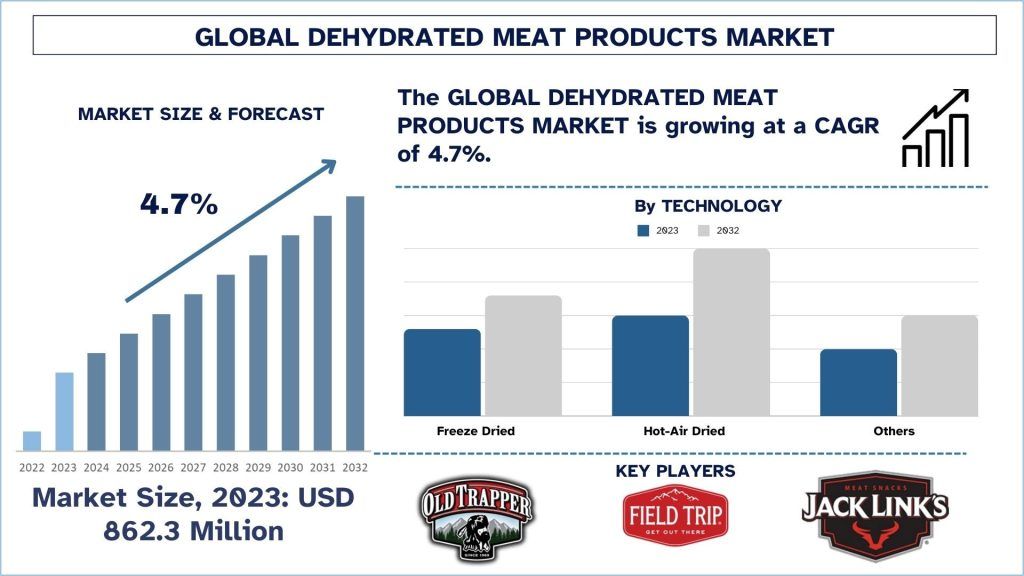
Wielkość i prognoza rynku dehydratyzowanych produktów mięsnych
Wartość rynku dehydratyzowanych produktów mięsnych została wyceniona na około ~862,3 mln USD w 2023 r. i oczekuje się, że będzie rósł w silnym tempie CAGR wynoszącym około 4,7% w okresie prognozy (2024-2032) ze względu na rosnący popyt na wygodne i trwałe produkty spożywcze na całym świecie.
Analiza rynku dehydratyzowanych produktów mięsnych
Rynek dehydratyzowanych produktów mięsnych odnotował ogromny wzrost z prostego powodu, że większość klientów woli kupować przetworzoną żywność, którą można łatwo przenosić, a także ze względu na jej jakość białka. Rynek obejmuje również różne rodzaje produktów mięsnych, w tym suszoną wołowinę, suszonego indyka, biltong i inne produkty wygodnej żywności, co wynika ze zwiększonego popytu na żywność wygodną w użyciu. Do czynników, które napędzały ten wzrost, należą świadomość zdrowotna, która zwiększyła popyt na produkty wysokobiałkowe i niskowęglowodanowe, dywersyfikacja produktów dostępnych na rynku oraz zmiany w formie, smakach i recepturach. Warto zauważyć, że rynek jest dobrze rozwinięty w Ameryce Północnej w porównaniu z innymi regionami i krajami i ma wyższy poziom spożycia na mieszkańca niż niektórzy z czołowych graczy rynkowych.
Ostatnie wydarzenia na rynku:
- W grudniu 2023 r. Natures Menu wprowadziło na rynek nową gamę surowej karmy dla psów, liofilizowanej, dzięki czemu można ją przechowywać w temperaturze otoczenia. Liofilizacja usuwa prawie całą zawartość wody bez gotowania, pomagając zachować wszystkie składniki odżywcze i smaki surowej żywności bez konieczności przechowywania opakowań w stanie zamrożonym. Dostępne w czterech smakach – wołowina, kurczak, indyk i jagnięcina.
- W listopadzie 2022 r. ROHA GROUP przejęła SARAF FOODS, firmę zajmującą się liofilizacją, aby rozszerzyć swoje portfolio technologii i produktów obejmujące suszone warzywa, owoce i zioła, oprócz istniejącego zakładu Newfoods we Włoszech.
Trendy na rynku dehydratyzowanych produktów mięsnych
W tej sekcji omówiono kluczowe trendy rynkowe, które wpływają na różne segmenty rynku dehydratyzowanych produktów mięsnych, zidentyfikowane przez nasz zespół ekspertów ds. badań.
Segment suszenia gorącym powietrzem transformuje przemysł
Rynek dehydratyzowanych produktów mięsnych odnotował stały wzrost w segmencie suszenia gorącym powietrzem ze względu na przestrzeganie koncepcji takich jak opłacalność i łatwość wdrożenia w porównaniu z innymi technikami suszenia. Z drugiej strony suszenie gorącym powietrzem obejmuje wykorzystanie ogrzanego powietrza, które dmucha na mięso w celu wyeliminowania wilgoci, a ten rodzaj suszenia sprawia, że produkt zachowuje główne składniki, takie jak smak i składniki odżywcze. Ta metoda jest najczęściej preferowana ze względu na jej wysoką zdolność adaptacji do użytku w dużych liniach produkcyjnych, co jest powszechne w przemyśle wytwórczym. Ponadto konsumenci przechodzą na różne sposoby pozyskiwania białka i poszukują wygodnych, wzbogaconych przekąsek mięsnych o długim okresie przydatności do spożycia, co pobudziło rynek produktów suszonych gorącym powietrzem. Jeśli chodzi o metodologię suszenia, suszenie gorącym powietrzem pozostaje kluczowe przy produkcji suszonego mięsa, ponieważ technologia ta jest wydajna i umożliwia produkcję szerokiej gamy produktów mięsnych po rozsądnych kosztach. Uważa się, że segment ten utrzyma tempo wzrostu, ponieważ z jednej strony zaspokaja potrzeby klientów wrażliwych na ceny, a z drugiej strony dostarcza żywność ogromnym branżom gastronomicznym.
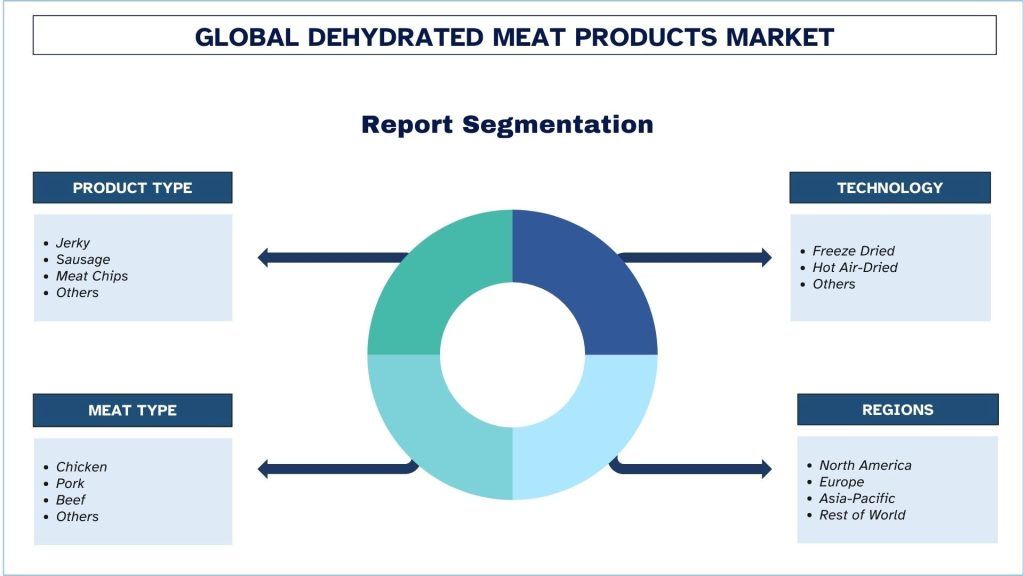
Ameryka Północna posiadała znaczący udział w rynku w 2023 roku
Rynek dehydratyzowanych produktów mięsnych w Ameryce Północnej również rozszerzył się dzięki takim czynnikom, jak ograniczenia czasowe, poziom świadomości i zapotrzebowanie na więcej białka, co przełożyło się na przenośne produkty mięsne. Wzrost wykorzystania przenośnych i trwałych produktów mięsnych w regionie ze względu na rosnącą rekreację na świeżym powietrzu, w tym piesze wędrówki i biwakowanie, również przyczynił się do poprawy wzrostu lub rozwoju rynku. Nowsze postępy w technologiach odwadniania i dodawanie lepszych i wysokiej klasy odmian również pomogły rynkowi rosnąć. Ponadto wzrost spożycia białka zachodzący równolegle z obawami o spożycie czerwonego mięsa i drobiu rozszerzył wybór konsumentów różnych dehydratyzowanych produktów mięsnych za pomocą sklepów internetowych i sieci detalicznych. Zgodnie z nawykami konsumenckimi obserwowanymi w Ameryce Północnej, ten oszczędny, a jednocześnie zdrowy rynek żywności pozostanie w stanie ciągłego wzrostu ze względu na ciągłe ulepszanie nowych produktów i rosnące zainteresowanie konsumentów.
- W lipcu 2024 r. amerykańska firma Natural Farm Pet, firma produkująca naturalne przysmaki dla psów, wprowadziła na rynek swoje najnowsze innowacje: Beef Cheek Rolls i Bully Cheek Rings. Według firmy, gryzaki mają być "wspaniałym dodatkiem" do diety żywieniowej psów.
- W październiku 2023 r. amerykańska firma Shepherd Boy Farms wprowadziła na rynek swoją nową liofilizowaną surową karmę dla psów, której celem jest dostarczenie farmy do misek psów i pomoc im w rozwoju. Dostępne w czterech recepturach, z których każda łączy białko premium z organicznymi całymi produktami.
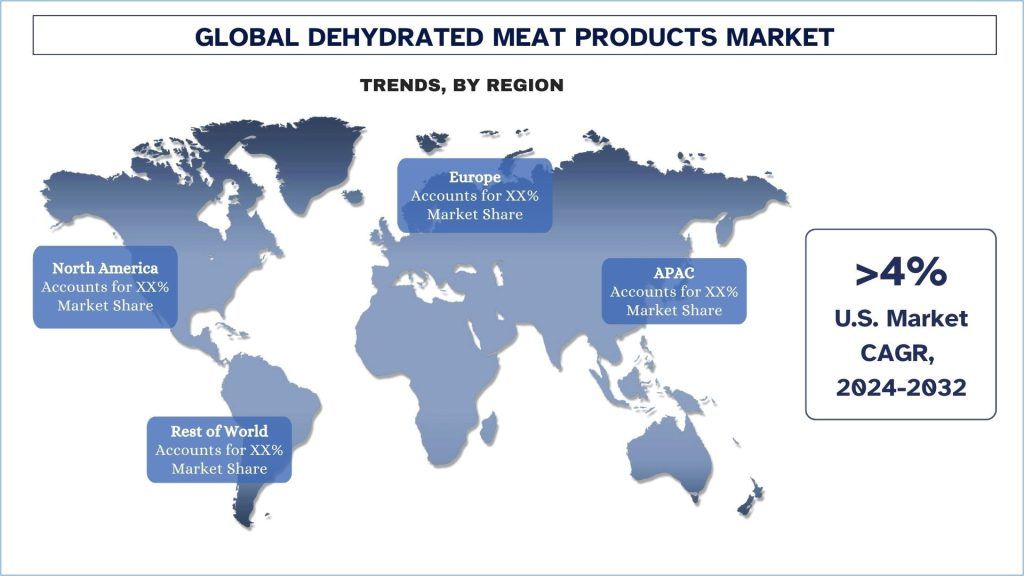
Przegląd branży dehydratyzowanych produktów mięsnych
Rynek dehydratyzowanych produktów mięsnych jest konkurencyjny, z kilkoma globalnymi i międzynarodowymi graczami rynkowymi. Kluczowi gracze przyjmują różne strategie rozwoju, aby zwiększyć swoją obecność na rynku, takie jak partnerstwa, umowy, współpraca, ekspansja geograficzna oraz fuzje i przejęcia. Niektóre z głównych graczy działających na rynku to Cargill, Incorporated; LINK SNACKS, INC.; Tyson Foods, Inc.; Stryve Biltong; Old Trapper Smoked Products; Country Archer Provisions; Hormel Foods Corporation; EPIC Provisions; FIELD TRIP SNACKS; i KRAVE PURE FOODS, INC.
Wiadomości z rynku dehydratyzowanych produktów mięsnych
- W maju 2024 r. marka CARNILOVE grupy VAFO wprowadziła na rynek nowe portfolio przysmaków dla psów, dostarczając liofilizowane przysmaki mięsne, aby zaspokoić instynktowne pragnienia psów. Według firmy te nowe liofilizowane przysmaki mięsne dla psów zawierają dużo świeżego mięsa i są delikatnie przetwarzane, aby zachować smak, aromat i niezbędne składniki odżywcze.
- We wrześniu 2023 r. eksporter przetworzonych produktów spożywczych i towarów rolnych Allana Group ogłosił zamiar utworzenia zakładu produkcji karmy dla zwierząt domowych o wartości 200 crore INR w pobliżu Zaheerabad w Telangana (Indie). Zakład o wydajności 10 ton/godzinę, produkujący produkty na bazie mięsa dla zwierząt domowych, rozpocznie działalność za kilka tygodni. Będzie to największy tego typu zakład w Azji, jak poinformowała firma w komunikacie z okazji wprowadzenia na rynek bogatych w białko suszonych produktów żywnościowych dla psów na rynek krajowy pod marką "Bowlers".
Zakres raportu o rynku dehydratyzowanych produktów mięsnych
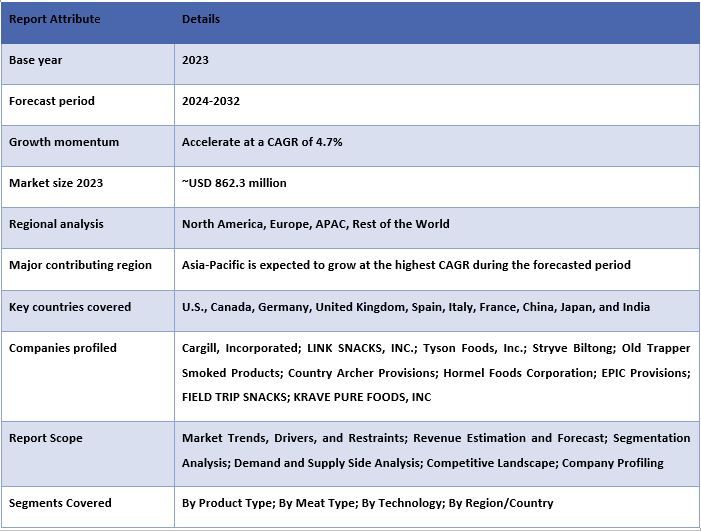
Powody, dla których warto kupić ten raport:
- Badanie obejmuje analizę wielkości rynku i prognoz zweryfikowaną przez uwierzytelnionych kluczowych ekspertów branżowych.
- Raport przedstawia szybki przegląd ogólnej wydajności branży w jednym rzucie oka.
- Raport obejmuje dogłębną analizę czołowych podmiotów w branży, z głównym naciskiem na kluczowe dane finansowe, portfele produktów, strategie ekspansji i najnowsze wydarzenia.
- Szczegółowe badanie czynników napędzających, ograniczeń, kluczowych trendów i możliwości występujących w branży.
- Badanie kompleksowo obejmuje rynek w różnych segmentach.
- Dogłębna analiza branży na poziomie regionalnym.
Opcje dostosowywania:
Globalny rynek dehydratyzowanych produktów mięsnych można dalej dostosować zgodnie z wymaganiami lub dowolnym innym segmentem rynku. Poza tym, UMI rozumie, że możesz mieć własne potrzeby biznesowe, więc skontaktuj się z nami, aby otrzymać raport, który w pełni odpowiada Twoim wymaganiom.
Spis treści
Metodologia Badawcza Analizy Rynku Dehydratyzowanych Produktów Mięsnych (2024-2032)
Analiza historycznego rynku, szacowanie obecnego rynku i prognozowanie przyszłego rynku globalnego rynku dehydratyzowanych produktów mięsnych to trzy główne kroki podjęte w celu stworzenia i analizy adaptacji dehydratyzowanych produktów mięsnych w głównych regionach na całym świecie. Przeprowadzono wyczerpujące badania wtórne w celu zebrania danych historycznych dotyczących rynku i oszacowania obecnej wielkości rynku. Po drugie, aby zweryfikować te spostrzeżenia, wzięto pod uwagę liczne ustalenia i założenia. Ponadto przeprowadzono również wyczerpujące wywiady pierwotne z ekspertami branżowymi w całym łańcuchu wartości globalnego rynku dehydratyzowanych produktów mięsnych. Po założeniu i zatwierdzeniu danych dotyczących rynku poprzez wywiady pierwotne, zastosowaliśmy podejście odgórne/oddolne do prognozowania całkowitej wielkości rynku. Następnie przyjęto metody podziału rynku i triangulacji danych w celu oszacowania i analizy wielkości rynku segmentów i podsegmentów danej branży. Szczegółowa metodologia jest wyjaśniona poniżej:
Analiza Historycznej Wielkości Rynku
Krok 1: Dogłębne Badanie Źródeł Wtórnych:
Przeprowadzono szczegółowe badanie wtórne w celu uzyskania historycznej wielkości rynku dehydratyzowanych produktów mięsnych za pośrednictwem wewnętrznych źródeł firmy, takich jak raporty roczne i sprawozdania finansowe, prezentacje wyników, komunikaty prasowe itp. oraz źródeł zewnętrznych, w tym czasopisma, wiadomości i artykuły, publikacje rządowe, publikacje konkurencji, raporty sektorowe, bazy danych stron trzecich i inne wiarygodne publikacje.
Krok 2: Segmentacja Rynku:
Po uzyskaniu historycznej wielkości rynku dehydratyzowanych produktów mięsnych przeprowadziliśmy szczegółową analizę wtórną w celu zebrania historycznych spostrzeżeń rynkowych i udziału dla różnych segmentów i podsegmentów dla głównych regionów. Główne segmenty zawarte w raporcie to rodzaj produktu, rodzaj mięsa, technologia i regiony. Przeprowadzono dalsze analizy na poziomie krajowym w celu oceny ogólnego wdrożenia modeli testowania w danym regionie.
Krok 3: Analiza Czynnikowa:
Po uzyskaniu historycznej wielkości rynku różnych segmentów i podsegmentów przeprowadziliśmy szczegółową analizę czynnikową w celu oszacowania obecnej wielkości rynku dehydratyzowanych produktów mięsnych. Ponadto przeprowadziliśmy analizę czynnikową przy użyciu zmiennych zależnych i niezależnych, takich jak rodzaj produktu, rodzaj mięsa, technologia i regiony rynku dehydratyzowanych produktów mięsnych. Przeprowadzono dokładną analizę scenariuszy po stronie popytu i podaży, biorąc pod uwagę najważniejsze partnerstwa, fuzje i przejęcia, ekspansję biznesową i wprowadzenie produktów na rynek w sektorze dehydratyzowanych produktów mięsnych na całym świecie.
Szacowanie Obecnej Wielkości Rynku i Prognoza
Szacowanie Obecnej Wielkości Rynku: W oparciu o praktyczne spostrzeżenia z powyższych 3 kroków, doszliśmy do obecnej wielkości rynku, kluczowych graczy na globalnym rynku dehydratyzowanych produktów mięsnych oraz udziałów w rynku poszczególnych segmentów. Wszystkie wymagane udziały procentowe i podziały rynku zostały określone przy użyciu wspomnianego powyżej podejścia wtórnego i zweryfikowane poprzez wywiady pierwotne.
Szacowanie i Prognozowanie: Do oszacowania rynku i prognozy przypisano wagi różnym czynnikom, w tym czynnikom napędzającym i trendom, ograniczeniom oraz możliwościom dostępnym dla interesariuszy. Po przeanalizowaniu tych czynników zastosowano odpowiednie techniki prognozowania, tj. podejście odgórne/oddolne, aby dojść do prognozy rynkowej na rok 2032 dla różnych segmentów i podsegmentów na głównych rynkach na całym świecie. Metodologia badawcza przyjęta do oszacowania wielkości rynku obejmuje:
- Wielkość rynku branży pod względem przychodów (USD) i wskaźnika adaptacji rynku dehydratyzowanych produktów mięsnych na głównych rynkach krajowych.
- Wszystkie udziały procentowe, podziały i rozbicia segmentów i podsegmentów rynku.
- Kluczowi gracze na globalnym rynku dehydratyzowanych produktów mięsnych pod względem oferowanych produktów. A także strategie rozwoju przyjęte przez tych graczy, aby konkurować na szybko rozwijającym się rynku.
Walidacja Wielkości i Udziału w Rynku
Badania Pierwotne: Przeprowadzono dogłębne wywiady z kluczowymi liderami opinii (KOL), w tym z kadrą kierowniczą najwyższego szczebla (CXO/VPs, szef sprzedaży, szef marketingu, szef operacyjny, szef regionalny, szef krajowy itp.) w głównych regionach. Następnie podsumowano wyniki badań pierwotnych i przeprowadzono analizę statystyczną w celu udowodnienia postawionej hipotezy. Dane wejściowe z badań pierwotnych zostały skonsolidowane z wynikami wtórnymi, przekształcając w ten sposób informacje w praktyczne spostrzeżenia.
Podział Uczestników Badań Pierwotnych w Różnych Regionach
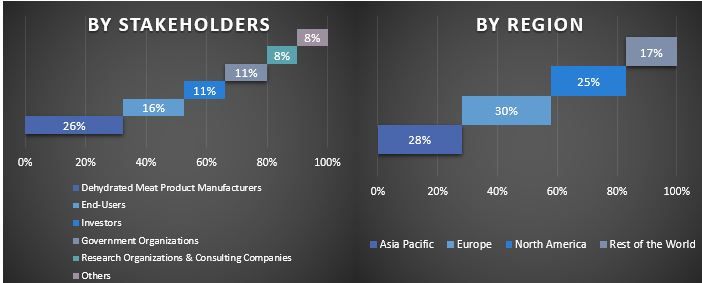
Inżynieria Rynkowa
Zastosowano technikę triangulacji danych w celu ukończenia ogólnego szacowania rynku i uzyskania precyzyjnych danych statystycznych dla każdego segmentu i podsegmentu globalnego rynku dehydratyzowanych produktów mięsnych. Dane zostały podzielone na kilka segmentów i podsegmentów po przestudiowaniu różnych parametrów i trendów w obszarach rodzaju produktu, rodzaju mięsa, technologii i regionów na globalnym rynku dehydratyzowanych produktów mięsnych.
Główny cel Globalnego Badania Rynku Dehydratyzowanych Produktów Mięsnych
W badaniu wskazano obecne i przyszłe trendy rynkowe globalnego rynku dehydratyzowanych produktów mięsnych. Inwestorzy mogą uzyskać strategiczne spostrzeżenia, na których mogą oprzeć swoją decyzję o inwestycjach w oparciu o analizę jakościową i ilościową przeprowadzoną w badaniu. Obecne i przyszłe trendy rynkowe określiły ogólną atrakcyjność rynku na poziomie regionalnym, zapewniając uczestnikom przemysłu platformę do wykorzystania niewykorzystanego rynku w celu czerpania korzyści z przewagi pioniera. Inne cele ilościowe badań obejmują:
- Analizę obecnej i prognozowanej wielkości rynku dehydratyzowanych produktów mięsnych pod względem wartości (USD). A także analizę obecnej i prognozowanej wielkości rynku różnych segmentów i podsegmentów.
- Segmenty w badaniu obejmują obszary rodzaju produktu, rodzaju mięsa, technologii i regionów.
- Definiowanie i analiza ram regulacyjnych dla dehydratyzowanych produktów mięsnych
- Analiza łańcucha wartości związanego z obecnością różnych pośredników, wraz z analizą zachowań klientów i konkurentów w branży.
- Analizę obecnej i prognozowanej wielkości rynku dehydratyzowanych produktów mięsnych dla głównego regionu.
- Główne kraje regionów analizowane w raporcie to Azja i Pacyfik, Europa, Ameryka Północna i Reszta Świata
- Profile firm z rynku dehydratyzowanych produktów mięsnych oraz strategie rozwoju przyjęte przez uczestników rynku w celu utrzymania się na szybko rozwijającym się rynku.
- Dogłębna analiza branży na poziomie regionalnym.
Najczęściej zadawane pytania FAQ
P1: Jaka jest obecna wielkość rynku odwodnionych produktów mięsnych i jego potencjał wzrostu?
P2: Jakie są czynniki napędzające wzrost rynku dehydratyzowanych produktów mięsnych?
P3: Który segment ma największy udział w rynku odwodnionych produktów mięsnych ze względu na rodzaj produktu?
P4: Jakie są nowe technologie i trendy na rynku dehydratyzowanych produktów mięsnych?
P5: Który region zdominuje rynek odwodnionych produktów mięsnych?
Powiązane Raporty
Klienci, którzy kupili ten przedmiot, kupili również










